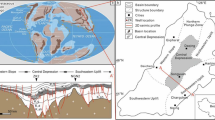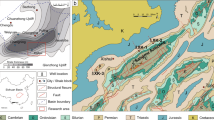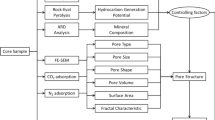Abstract
Both shales and tight sandstones have complex and heterogeneous pore systems that largely determine reservoir quality. However, there are few published data integrating the pore structure of shales and tight sandstones in coal-bearing sequences. This study presents a pore structure characterization of the Carboniferous–Permian (C3t–P1s) shales and tight sandstones of the Taiyuan-Shanxi coal-bearing succession in the Qinshui Basin of Shanxi Province, north China. Methods employed to investigate the nanoscale pore structure (< 100 nm) of shales include low-pressure CO2 adsorption at 273 K and N2 adsorption at 77 K, whereas high-pressure mercury intrusion (HPMI) analysis has been used to quantify the pore structure of tight sandstones.
The results indicated that the C3t–P1s transitional shales entered the high maturity stage and contain abundant quartz, clay minerals, and organic matter (OM). Pores in shales are mainly hosted in OM and clay minerals with a wide range of total pore volumes (PVtotal = 0.021–0.040 cm3/g) and total specific surface areas (SSAtotal = 9.98–26.46 m2/g), which are mostly represented by micropores and mesopores. Micropores in the shales were predominantly controlled by the OM, whereas mesopore and macropore development was clearly controlled by clay content. The contribution of clay-hosted pores to shale porosity was much greater than that of OM pores. The C3t–P1s tight sandstones feature abundant pores at sizes smaller than 100 nm with complex pore structures. Larger pore throats (> rapex) with good connectivity account for only a small fraction of the total pore volume but show significant controls on the sandstone permeability. Unlike the clay minerals and quartz in the shales, clay minerals play a negative role in sandstone porosity and permeability, whereas the quartz content contributes positively to reservoir properties due to residual primary intergranular pores. Feldspar and ankerite in the sandstones help to generate secondary dissolved pores, which greatly improve reservoir quality.





















Similar content being viewed by others
References
Ajdukiewicz JM, Lander RH (2010) Sandstone reservoir quality prediction: the state of the art. AAPG Bull 94(8):1083–1091
Ayinla HA, Wan HA, Makeen YM, Abubabar M, Jauro A, Mohammed B, Abidin NSZ (2017) Petrographic and geochemical characterization of the Upper Cretaceous coal and mudstones of Gombe Formation, Gongola sub-basin, northern Benue trough Nigeria: implication for organic matter preservation, paleodepositional environment and tectonic settings. Int J Coal Geol 180:67–82
Bai B, Zhu R, Wu S, Yang W, Gelb J, Gu A, Zhang X, Su L (2013) Multi-scale method of Nano(Micro)-CT study on microscopic pore structure of tight sandstone of Yanchang Formation. Ordos Basin Pet Explor Dev 40(3):354–358
Barrett, E.P., Joyner, L.G., Halenda, P.P., 1951. The determination of pore volume and area distributions in porous substances. I. Computations from nitrogen isotherms. J. Am. Chem. Soc. 73(1), 373–380.
Bloch S, Lander RH, Bonnell L (2002) Anomalously high porosity and permeability in deeply buried sandstone reservoirs: origin and predictability. AAPG Bull 86(2):301–328
Bustin, R.M., Bustin, A.M.M., Cui, A., Ross, D., Pathi, V.M., 2008. Impact of shale properties on pore structure and storage characteristics. SPE Shale Gas Production Conference. Society of Petroleum Engineers, Fort Worth, Texas, USA, p 28.
Cai, Y., Liu, D., Yao, Y., Li, J., Qiu, Y., 2011. Geological controls on prediction of coalbed methane of No. 3 coal seam in Southern Qinshui Basin, North China. Int. J. Coal Geol. 88(2), 101–112.
Cao, Q., 1985. Identification of microcomponents and types of kerogen under transmitted light. Pet. Explor. Dev. 12(5), 18–27+85–92.
Chalmers GRL, Bustin RM (2007) The organic matter distribution and methane capacity of the Lower Cretaceous strata of Northeastern British Columbia. Canada Int J Coal Geol 70(1):223–239
Chen S, Zhu Y, Qin Y, Wang H, Liu H, Fang J (2014) Reservoir evaluation of the Lower Silurian Longmaxi Formation shale gas in the southern Sichuan Basin of China. Mar Pet Geol 57:619–630
Clarkson CR, Freeman M, He L, Agamalian M, Melnichenko YB, Mastalerz M, Bustin RM, Radliński AP, Blach TP (2012) Characterization of tight gas reservoir pore structure using USANS/SANS and gas adsorption analysis. Fuel 95:371–385
Clarkson CR, Jensen JL, Pedersen PK, Freeman M (2012) Innovative methods for flow-unit and pore-structure analyses in a tight siltstone and shale gas reservoir. AAPG Bull 96(2):355–374
Clarkson CR, Solano N, Bustin RM, Bustin AMM, Chalmers GRL, He L, Melnichenko YB, Radliński AP, Blach TP (2013) Pore structure characterization of North American shale gas reservoirs using USANS/SANS, gas adsorption, and mercury intrusion. Fuel 103:606–616
Desbois G, Urai JL, Kukla PA, Konstanty J, Baerle C (2011) High-resolution 3D fabric and porosity model in a tight gas sandstone reservoir: a new approach to investigate microstructures from mm- to nm-scale combining argon beam cross-sectioning and SEM imaging. J Pet Sci Eng 78(2):243–257
Durand, B., Nicaise, G., 1980. Procedures for kerogen isolation. Kerogen, Insoluble Organic Matter from Sedimentary Rocks (Durand, B., ed.), 35–53, Editions Technip, Paris.
Fishman NS, Hackley PC, Lowers HA, Hill RJ, Evenhoff SO, Eberl DD, Blum AE (2012) The nature of porosity in organic-rich mudstones of the Upper Jurassic Kimmeridge Clay Formation, North Sea, offshore United Kingdom. Int J Coal Geol 103:32–50
Folk R (1980) Petrology of sedimentary rocks. Hemphill Publishing Company, Austin, Texas, USA
Gao H, Li HA (2016) Pore structure characterization, permeability evaluation and enhanced gas recovery techniques of tight gas sandstones. J Nat Gas Sci Eng 28:536–547
Hazra B, Vishal V, Singh DP (2020) Applicability of low-pressure CO2 and N2 adsorption in determining pore attributes of organic-rich shales and coals. E&F 35(1):456–464
Hazra B, Wood DA, Singh PK, Singh AK, Sahu G (2020) Source rock properties and pore structural framework of the gas-prone Lower Permian shales in the Jharia basin. India Arab J Geosci 13(13):1–18
He J, Zhang X, Ma L, Wu H, Ashraf MA (2016) Geological characteristics of unconventional gas in coal measure of Upper Paleozoic coal measures in Ordos Basin. China Earth Sci Res J 20(1):1–5
Holmes R, Rupp EC, Vishal V, Wilcox J (2017) Selection of shale preparation protocol and outgas procedures for applications in low-pressure analysis. E&F 31(9):9043–9051
Jiang F, Chen D, Wang Z, Xu Z, Chen J, Liu L, Huyan Y, Liu Y (2016) Pore characteristic analysis of a lacustrine shale: a case study in the Ordos Basin, NW China. Mar Pet Geol 73:554–571
Kassab MA, Hashish MFA, Nabawy BS, Elnaggar OM (2017) Effect of kaolinite as a key factor controlling the petrophysical properties of the Nubia sandstone in central Eastern Desert. Egypt J Afr Earth Sci 125:103–117
Kaufmann J, Loser R, Leemann A (2009) Analysis of cement-bonded materials by multi-cycle mercury intrusion and nitrogen sorption. J Colloid Interface Sci 336(2):730–737
Kuila U, McCarty DK, Derkowski A, Fischer TB, Topór T, Prasad M (2014) Nano-scale texture and porosity of organic matter and clay minerals in organic-rich mudrocks. Fuel 135:359–373
Kuila U, Prasad M (2013) Specific surface area and pore-size distribution in clays and shales. Geophys Prospect 61(2):341–362
Lai J, Wang G, Cao J, Xiao C, Wang S, Pang X, Dai Q, He Z, Fan X, Yang L, Qin Z (2017) Investigation of pore structure and petrophysical property in tight sandstones. Mar Pet Geol 91:179–189
Lai J, Wang G, Chai Y, Ran Y, Zhang X (2015) Depositional and diagenetic controls on pore structure of tight gas sandstone reservoirs: evidence from Lower Cretaceous Bashijiqike Formation in Kelasu thrust belts, Kuqa depression in Tarim Basin of west China. Resour Geol 65(2):55–75
Lai J, Wang G, Wang Z, Chen J, Pang X, Wang S, Zhou Z, He Z, Qin Z, Fan X (2018) A review on pore structure characterization in tight sandstones. Earth-Sci Rev 177:436–457
Li J, Tang S, Zhang S, Li L, Wei J, Xi Z, Sun K (2018) Characterization of unconventional reservoirs and continuous accumulations of natural gas in the Carboniferous-Permian strata, mid-eastern Qinshui basin. China J Nat Gas Sci Eng 49:298–316
Li X, Jiang Z, Jiang S, Wang S, Cao X (2021) Synergetic effects of matrix components and diagenetic processes on pore properties in the Lower Cambrian shale in Sichuan basin, South China. J Nat Gas Sci Eng 94(4–5):104072
Li Y, Tang D, Wu P, Niu X, Wang K, Qiao P, Wang Z (2016) Continuous unconventional natural gas accumulations of Carboniferous-Permian coal-bearing strata in the Linxing area, northeastern Ordos basin. China J Nat Gas Sci Eng 36:314–327
Liu Y, Zhu Y (2016) Comparison of pore characteristics in the coal and shale reservoirs of Taiyuan Formation, Qinshui Basin. China Int J Coal Sci Technol 3(3):330–338
Loucks RG, Reed RM, Ruppel SC, Hammes U (2012) Spectrum of pore types and networks in mudrocks and a descriptive classification for matrix-related mudrock pores. AAPG Bull 96(6):1071–1098
Loucks RG, Reed RM, Ruppel SC, Jarvie DM (2009) Morphology, genesis, and distribution of nanometer-scale pores in siliceous mudstones of the Mississippian Barnett Shale. J Sediment Res 79(12):848–861
Lowell S, Shields JE, Thomas MA, Thommes M (2004) Characterization of porous solids and powders: surface area, pore size and density. Springer
Ma Y, Zhong N, Li D, Pan Z, Cheng L, Liu K (2015) Organic matter/clay mineral intergranular pores in the Lower Cambrian Lujiaping Shale in the north-eastern part of the upper Yangtze area, China: a possible microscopic mechanism for gas preservation. Int J Coal Geol 137:38–54
Mastalerz M, He L, Melnichenko YB, Rupp JA (2012) Porosity of coal and shale: Insights from gas adsorption and SANS/USANS techniques. E&F 26:5109–5120
Mastalerz M, Schimmelmann A, Drobniak A, Chen Y (2013) Porosity of Devonian and Mississippian New Albany Shale across a maturation gradient: Insights from organic petrology, gas adsorption, and mercury intrusion. AAPG Bull 97(10):1621–1643
Morad S, Al-Ramadan K, Ketzer JM, De Ros LF (2010) The impact of diagenesis on the heterogeneity of sandstone reservoirs: a review of the role of depositional facies and sequence stratigraphy. AAPG Bull 94(8):1267–1309
Naseer MT, Asim S (2018) Porosity prediction of Lower Cretaceous unconventional resource play, south Indus Basin, Pakistan, using the seismic spectral decomposition technique. Arab J Geosci 11(10):1–13
Nelson PH (2009) Pore-throat sizes in sandstones, tight sandstones, and shales. AAPG Bull 93(3):329–340
Nie B, Liu X, Yang L, Meng J, Li X (2015) Pore structure characterization of different rank coals using gas adsorption and scanning electron microscopy. Fuel 158:908–917
Pittman ED (1992) Relationship of porosity and permeability to various parameters derived from mercury injection-capillary pressure curves for sandstone (1). AAPG Bull 76(2):191–198
Pommer M, Milliken K (2015) Pore types and pore-size distributions across thermal maturity, Eagle Ford Formation, southern Texas. AAPG Bull 99(9):1713–1744
Ramm M (2000) Reservoir quality and its relationship to facies and provenance in Middle to Upper Jurassic sequences, northeastern North Sea. Clay Miner 35(1):77–94
Ross DJK, Bustin RM (2009) The importance of shale composition and pore structure upon gas storage potential of shale gas reservoirs. Mar Pet Geol 26(6):916–927
Rouquerol J, Avnir D, Fairbridge CW, Everett DH, Haynes JH, Pernicone N, Ramsay JDF, Sing KSW, Unger K (1994) Recommendations for the characterization of porous solids, International Union of Pure and Applied Chemistry. Pure Appl Chem 68:1739–1758
Schmid S, Worden RH, Fisher QJ (2004) Diagenesis and reservoir quality of the Sherwood Sandstone (Triassic), Corrib Field, Slyne Basin, west of Ireland. Mar Pet Geol 21(3):299–315
Schmitt M, Fernandes CP, Wolf FG, da Cunha B, Neto JA, Rahner CP, Santiago dos Santos VS (2015) Characterization of Brazilian tight gas sandstones relating permeability and Angstrom-to micron-scale pore structures. J Nat Gas Sci Eng 27:785–807
Shao L, Xiao Z, Lu J, He Z, Wang H, Zhang P (2007) Permo-Carboniferous coal measures in the Qinshui basin: lithofacies paleogeography and its control on coal accumulation. Front Earth Sci China 1(1):106–115
Shao X, Pang X, Jiang F, Li L, Huyan Y, Zheng D (2017) Reservoir characterization of tight sandstones using nuclear magnetic resonance and incremental pressure mercury injection experiments: implication for tight sand gas reservoir quality. Energy Fuels 31(10):10420–10431
Sing KS (1985) Reporting physisorption data for gas/solid systems with special reference to the determination of surface area and porosity. Pure Appl Chem 57(4):603–619
Sing KS (1995) Physisorption of nitrogen by porous materials. J Porous Mater 2(1):5–8
Singh DP, Chandra D, Vishal V, Hazra B, Sarkar P (2021) Impact of degassing time and temperature on the estimation of pore attributes in shale. E&F 35:15628–15641
Singh DP, Singh V, Singh PK, Hazra B (2021b) Source rock properties and pore structural features of distinct thermally mature Permian shales from South Rewa and Jharia basins. India Arab J Geosci 14(10):1–16
Singh DP, Wood DA, Hazra B, Singh PK (2021) Pore properties in organic-rich shales derived using multiple fractal determination models applied to two Indian Permian basins. E&F 35:14618–14633
Song Y, Liu S, Zhang Q, Tao M, Zhao M, Hong F (2012) Coalbed methane genesis, occurrence and accumulation in China. Pet Sci 9(3):269–280
Su X, Lin X, Liu S, Zhao M, Song Y (2005) Geology of coalbed methane reservoirs in the Southeast Qinshui Basin of China. Int J Coal Geol 62(4):197–210
Su X, Lin X, Zhao M, Song Y, Liu S (2005) The upper Paleozoic coalbed methane system in the Qinshui basin. China AAPG Bull 89(1):81–100
Suleimenova A, Bake KD, Ozkan A, Valenza JJ, Kleinberg RL, Burnham AK, Ferralis N, Pomerantz AE (2014) Acid demineralization with critical point drying: a method for kerogen isolation that preserves microstructure. Fuel 135:492–497
Swanson BF (1979) Visualizing pores and nonwetting phase in porous rock. J Pet Technol 31(01):10–18
Swanson BF (1981) A simple correlation between permeabilities and mercury capillary pressures. J Pet Technol 33(12):2498–2504
Thomeer JHM (1960) Introduction of a pore geometrical factor defined by the capillary pressure curve. J Pet Technol 12(3):73–77
Vishnyakov A, Ravikovitch PI, Neimark AV (1999) Molecular level models for CO2 sorption in nanopores. Langmuir 15(25):8736–8742
Wang L, Zhao N, Sima L, Meng F, Guo Y (2018) Pore structure characterization of the tight reservoir: systematic integration of mercury injection and nuclear magnetic resonance. Energy Fuels 32(7):7471–7484
Wang Y, Liu L, Cheng H (2021) Gas adsorption characterization of pore structure of organic-rich shale: insights into contribution of organic matter to shale pore network. Nat Resour Res 30(3):2377–2395
Washburn EW (1921) Note on a method of determining the distribution of pore sizes in a porous material. Proc Natl Acad Sci USA 7(4):115–116
Wei C, Qin Y, Wang GGX, Fu X, Jiang B, Zhang Z (2007) Simulation study on evolution of coalbed methane reservoir in Qinshui basin. China Int J Coal Geol 72(1):53–69
Wei M, Zhang L, Xiong Y, Li J, Peng Pa (2016) Nanopore structure characterization for organic-rich shale using the non-local-density functional theory by a combination of N2 and CO2 adsorption. Microporous Mesoporous Mater 227:88–94
Xi Z, Tang S, Zhang S, Sun K (2017) Pore structure characteristics of marine–continental transitional shale: a case study in the Qinshui Basin. China Energy Fuels 31(8):7854–7866
Xu ZJ, Liu LL, Liu BJM, Wang TG, Zhang ZH, Wu KJ, Feng CY, Dou WC, Wang Y, Shu Y (2019) Geochemical characteristics of the Triassic Chang 7 lacustrine source rocks, Ordos Basin, China: implications for paleoenvironment, petroleum potential and tight oil occurrence. J Asian Earth Sci 178:112–138
Xu ZJ, Wang Y, Jiang S, Fang C, Liu LF, Wu KJ, Luo Q, Li X, Chen YY (2022) Impact of input, preservation and dilution on organic matter enrichment in lacustrine rift basin: a case study of lacustrine shale in Dehui Depression of Songliao Basin. NE China Mar Petrol Geol 135:105386
Yan G, Wei C, Song Y, Zhang J (2017) Pore characteristics of organic-rich shale in the Carboniferous-Permian coal-bearing strata in Qinshui Basin. Energy Explor Exploit 35(5):645–662
Yang C, Zhang J, Wang X, Tang X, Chen Y, Jiang L, Gong X (2017) Nanoscale pore structure and fractal characteristics of a marine-continental transitional shale: a case study from the Lower Permian Shanxi Shale in the southeastern Ordos Basin. China Mar Pet Geol 88:54–68
Yang F, Ning Z, Wang Q, Liu H (2016) Pore structure of Cambrian shales from the Sichuan Basin in China and implications to gas storage. Mar Petrol Geol 70:14–26
Zahid MA, Dong C, Golab AN, Lin C, Zhang X, Ge X, Wu S, Munawar MJ, Ma C, Knuefing L (2019) Pore size distribution and reservoir characterization: evaluation for the Eocene beach-bar sequence, Dongying Depression. China Arab J Geosci 12(21):1–14
Zeng YH, Fu XG, Zeng SQ, Du G (2013) Upper Triassic potential source rocks in the Qiangtang Basin, Tibet: organic geochemical characteristics. J Pet Geol 36:237–255
Zhang Z, Qin Y, Fu X, Yang Z, Guo C (2015) Multi-layer superposed coalbed methane system in southern Qinshui Basin, Shanxi Province. China J Earth Sci 26(3):391–398
Zhu G, Gu L, Su J, Dai J, Ding W, Zhang J, Song L (2012) Sedimentary association of alternated mudstones and tight sandstones in China’s oil and gas bearing basins and its natural gas accumulation. J Asian Earth Sci 50:88–104
Zou C, Zhu R, Liu K, Su L, Bai B, Zhang X, Yuan X, Wang J (2012) Tight gas sandstone reservoirs in China: characteristics and recognition criteria. J Pet Sci Eng 88:82–91
Acknowledgements
The authors would like to thank the Shanxi Provincial Coal Geology Geophysical Prospecting, Surveying and Mapping Institute for sample support.
Funding
This study was jointly supported by the China Scholarship Council (CSC), the Natural Science Foundation of Chongqing, China [NO. cstc2021jcyjmsxmX0733] and the Research Funding from Chongqing University of Science and Technology [NO. 182001003].
Author information
Authors and Affiliations
Ethics declarations
Competing interests
The authors declare no competing interests.
Additional information
Responsible editor: Santanu Banerjee
Rights and permissions
About this article
Cite this article
Li, J., Tang, S., Ettensohn, F. et al. Characterization of pore structure in Carboniferous–Permian gas shales and tight sandstones of the coal-bearing succession in the Qinshui Basin, north China. Arab J Geosci 15, 1125 (2022). https://doi.org/10.1007/s12517-022-10325-w
Received:
Accepted:
Published:
DOI: https://doi.org/10.1007/s12517-022-10325-w




